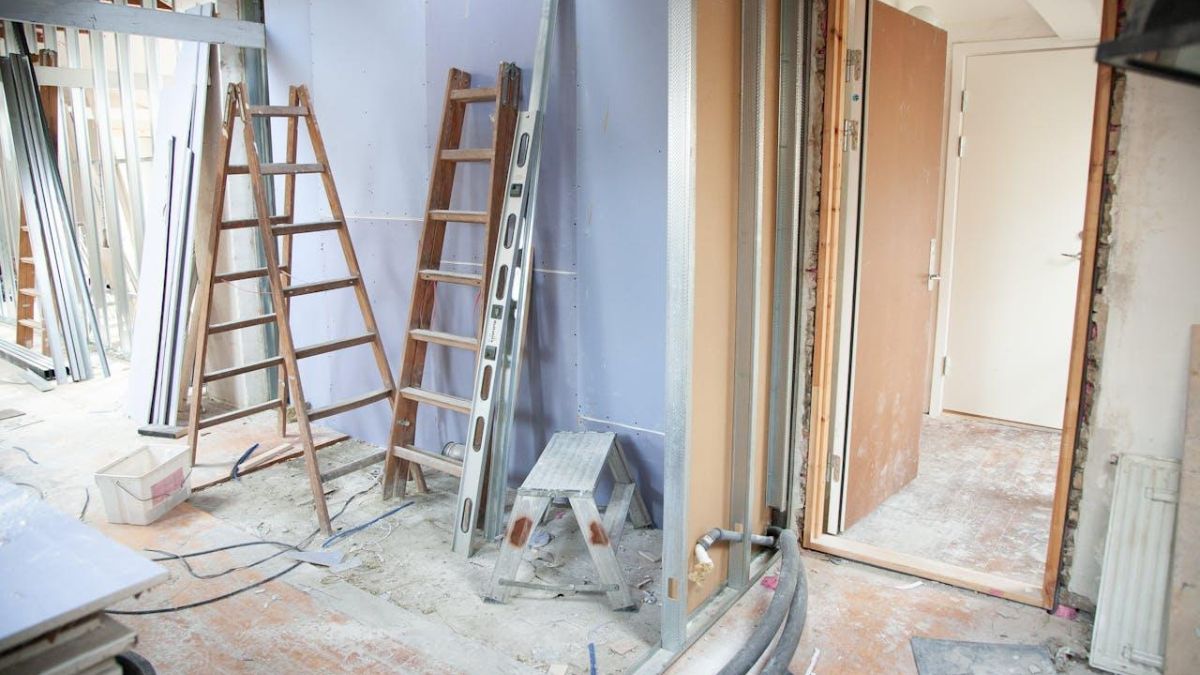HOME
A Beginner’s Guide To Managing A Remodel

Are you planning your first home remodel and feeling a bit overwhelmed by the process? Remodeling your home can be an exciting process that transforms your living space, but it also requires careful planning and management to ensure success. From setting a budget to choosing the right contractors, each step is key in making your vision a reality. In this blog, we will share essential tips and strategies to help you tackle — and get done with — the remodeling process smoothly and effectively.
Understanding Your Goals and Vision
Before any actual remodeling work begins, it’s critical to have a clear understanding of what you want to achieve. Start by asking yourself why you want to remodel in the first place. Are you looking to update an outdated kitchen, add a bathroom, or perhaps expand your living room space for a growing family? Defining your primary goals will help guide all subsequent decisions, from design to materials. It also helps in communicating your vision clearly to designers, contractors, and any other professionals involved, ensuring that the final results align closely with your expectations.
Planning Your Budget
One of the most important aspects of managing a remodel is establishing and sticking to a budget. Begin by researching the average cost of similar remodels in your area, and then break down your budget to cover all aspects of the project, including materials, labor, design fees, and any necessary permits. Don’t forget to set aside a contingency fund—typically 10-20% of the total budget—to handle unexpected costs that often arise during remodeling projects. Here, experienced professionals can help you. Companies like Tailored Remodelling can offer valuable insights and help you understand what financial commitment your specific renovation will require, ensuring that your budget is realistic and sufficient.
Choosing the Right Professionals
Finding and hiring the right contractor is pivotal to the success of your remodeling project. Start by seeking recommendations from friends or family who have recently undergone similar projects, or search for local contractors with excellent reviews online. Once you have a few candidates, interview each one to discuss your project in detail and assess whether they understand your vision and can meet your expectations. It’s also essential to verify that they are licensed, insured, and have no major complaints filed against them. Choosing someone experienced and trustworthy will make a significant difference in the smooth execution of your remodel.
Design and Layout
The design phase is where your ideas begin to take shape. Whether you’re working with an architect or a designer, it’s important to be involved in the process to ensure the plans reflect your vision and functional needs. Good design not only considers the aesthetics of your space but also how efficiently the space is used. For example, kitchen remodels should consider the workflow between the stove, sink, and refrigerator. During this phase, review and revise preliminary designs and be sure to approve final drawings before construction begins. This proactive involvement helps prevent costly and time-consuming changes once the project is underway.
Navigating Permits and Regulations
Many homeowners might find the permitting process daunting, but it’s an essential step in ensuring your remodel complies with local building codes and safety regulations. Typically, your contractor will handle the acquisition of permits, but understanding what permits are necessary for your particular project can help you oversee the process more effectively. This might involve structural changes, electrical upgrades, or significant alterations to plumbing systems. Ensuring that all necessary permits are obtained before work begins can prevent legal issues and potential fines, as well as ensure that the work is done legally and safely.
Preparing Your Home
Getting your home ready for the remodeling process is an essential step that should not be overlooked. This includes clearing out the remodeling area and possibly securing alternative living arrangements if the project is extensive. Protecting your belongings from dust and debris involves covering furniture and sealing off non-work areas. If you’re staying in the house during the remodel, set up a temporary kitchen or living space to minimize disruption to your daily routines. Preparation helps in minimizing stress and keeping your home organized and functional during the chaos of renovation.
Communication is Key
Effective communication with your contractor and their team throughout the project cannot be overstated. Regular meetings can help ensure that everyone is on the same page and that any concerns are addressed promptly. It’s also a chance to make adjustments as needed and to stay informed about the progress of the work. Clear, open communication will help prevent misunderstandings and ensure that the project meets your expectations.
Dealing with Challenges
No remodel goes perfectly according to plan, and you’re likely to face a few challenges along the way. Whether it’s unexpected structural issues, delays in materials, or going over budget, it’s important to stay flexible and solution-focused. Work closely with your contractor to find the best way forward when these issues arise, and keep your contingency fund in mind for these exact scenarios. Staying calm and proactive when facing obstacles is key to managing a successful remodel.
The Finishing Touches
As your remodel nears completion, paying attention to the finishing touches is extremely important. This includes a thorough review of the craftsmanship, making sure all fixtures are installed correctly, and ensuring that every detail aligns with your vision. Walk through the space with your contractor to create a punch list of any unfinished tasks or corrections needed. This final step is crucial for ensuring the quality and completeness of the remodel before making the final payments.
The Bottom Line
Managing your first home remodel is an involved process that requires careful planning, open communication, and a bit of flexibility. By understanding your goals, setting a realistic budget, choosing the right professionals, and staying engaged throughout the process, you can effectively oversee your home’s transformation. Keep in mind that the key to a successful remodel is not just in achieving the desired outcome, but in ensuring the journey is organized and meets your expectations. With the right approach, your remodel can significantly improve your living space and add value to your home. Take these insights and strategies to heart to make your remodeling experience as smooth and rewarding as possible.
HOME
The Art of Living: Inside a Luxurious polish villa Retreat

Nestled in the heart of Poland, a luxurious polish villa retreat awaits those seeking an escape from the ordinary. Imagine stepping into a world where elegance meets tranquility, surrounded by breathtaking landscapes and rich history. This isn’t just any getaway; it’s an invitation to experience life at its finest in a stunning Polish villa that embodies charm and sophistication. Whether you’re looking for relaxation or adventure, this retreat promises to indulge your senses and rejuvenate your spirit. Get ready to discover what makes this destination truly special!
The History and Architecture of the Villa
The Polish villa stands as a testament to the country’s rich architectural heritage. Built during the late 19th century, this magnificent structure showcases a blend of neo-Renaissance and Baroque influences. Intricate moldings and grand arches reflect artistry from a bygone era.
As you stroll through its halls, each room tells a story. High ceilings adorned with lavish frescoes capture the imagination, while polished wooden floors add warmth.
Surrounding gardens enhance its charm. Lush greenery complements the villa’s elegant facade, offering guests picturesque views in every direction. Stone pathways lead to tranquil corners perfect for reflection or relaxation.
This villa is not just about opulence; it embodies history itself—an enduring symbol of Poland’s cultural evolution and aesthetic vision throughout generations.
Luxurious Amenities and Services Offered
At the Polish villa retreat, luxury takes on a whole new meaning. Every corner of this exquisite property is designed with comfort in mind.
Guests can unwind in spacious suites adorned with elegant furnishings and modern decor. Each room boasts breathtaking views of the surrounding landscape, creating a serene atmosphere for relaxation.
The retreat offers a gourmet restaurant featuring local cuisine prepared by top chefs. Guests are invited to savor delicious meals made from fresh ingredients sourced from nearby farms.
For those seeking rejuvenation, an exclusive spa awaits. Indulge in relaxing treatments that incorporate traditional Polish wellness practices alongside contemporary techniques.
Outdoor enthusiasts will appreciate well-maintained gardens and private walking trails. Whether you prefer leisurely strolls or invigorating hikes, nature’s beauty surrounds you at every turn.
Personalized services cater to individual needs, ensuring that each stay feels unique and unforgettable.
Activities and Experiences at the Retreat
At the Polish villa retreat, every moment is designed to inspire and rejuvenate. Guests can immerse themselves in nature with guided hikes through lush landscapes, where vibrant flora and fauna abound.
For those seeking relaxation, the on-site spa offers a range of treatments that blend traditional techniques with modern luxuries. Imagine unwinding with a soothing massage while overlooking stunning views.
Culinary enthusiasts will delight in cooking classes led by renowned chefs who showcase local ingredients. The experience culminates in feasting on gourmet dishes crafted from your creations.
Adventure lovers have access to activities such as horseback riding or kayaking along serene waterways.
Evenings bring opportunities for cultural immersion with live music performances and storytelling sessions around a crackling fire, celebrating the rich heritage of Poland’s history.
Testimonials from Previous Guests
Guests rave about their experiences at the Polish villa retreat. Many describe it as a hidden gem that exceeds expectations.
One visitor noted, “The tranquility here is unmatched. I felt completely rejuvenated after just a few days.” The serene atmosphere combined with stunning views creates an unforgettable backdrop for relaxation.
Another guest mentioned the attentive staff: “They anticipated our needs without being intrusive. It made our stay feel truly personal.” Such service enhances the luxurious experience.
Several families appreciate the range of activities available, stating, “Our kids loved exploring nature while we indulged in spa treatments.”
These heartfelt stories reflect a common theme—each visit leaves lasting memories, prompting many to return again and again. The charm of this Polish villa captivates all who enter its doors.
Conclusion:
The Polish villa retreat offers an exquisite escape that transcends the ordinary. Each corner of this enchanting property whispers stories of tradition and elegance.
Staying here is more than just a getaway; it’s an experience that lingers long after your departure. The blend of rich history, stunning architecture, and modern luxuries creates a unique atmosphere.
Guests leave with cherished memories crafted from personalized services and breathtaking surroundings. Nature beckons at every turn, inviting exploration or relaxation in equal measure.
Whether savoring gourmet meals or indulging in spa treatments, each moment feels special. This retreat stands as a testament to the art of living well amidst serene beauty.
FAQ’S
What is the best time to visit the Polish villa?
The villa’s beauty shines year-round, but late spring and early autumn provide pleasant weather. You’ll enjoy stunning landscapes and outdoor activities during these seasons.
Are meals included in my stay?
Yes, most packages include gourmet dining options prepared by talented chefs who focus on local cuisine. Dietary restrictions can be accommodated with prior notice.
Is transportation available from nearby airports?
Absolutely! The retreat offers shuttle services from major airports for a convenient start to your getaway.
BUSINESS
Exploring www.hura-watch.net business archives: A Deep Dive into Its Business Archives

Welcome to the world of www.hura-watch.net, where business archives come alive! If you’ve ever wondered how historical data can shape modern strategies, you’re in for a treat. This platform is more than just a repository; it’s an invaluable resource for companies seeking insights from their past. Whether you’re a budding entrepreneur or part of a seasoned corporation, understanding what lies within these archives could be your ticket to smarter decision-making and innovative growth. Let’s embark on this journey together as we explore the depths of Hura’s extensive business archives and uncover why they matter so much to today’s businesses.
The importance of business archives for companies
Business archives play a crucial role in preserving a company’s legacy. They serve as a repository of vital information, from financial records to marketing strategies.
These archives provide context and insight into past decisions, helping companies understand their journey. This historical perspective is invaluable for future planning and strategy development.
Moreover, well-maintained archives enhance transparency and accountability. Stakeholders can easily access essential documents, fostering trust within the organization.
In addition to internal value, business archives can be leveraged externally for brand storytelling. Sharing historical milestones can strengthen customer relationships by showcasing reliability and growth over time.
Effective archiving aids compliance with legal regulations. Companies are better equipped to respond to audits or inquiries when they have organized records at hand.
Key features of Hura-watch.net’s business archives
Hura-watch.net boasts a range of key features that make its business archives invaluable. First and foremost, the user-friendly interface allows easy navigation through extensive collections. This ensures users can swiftly locate specific documents or resources.
Another standout feature is the comprehensive categorization of archived materials. Users can explore various sectors, making it simple to find relevant information tailored to their needs.
Search functionality enhances accessibility even further. With advanced filters and keyword search options, users can pinpoint exact content with ease.
Additionally, Hura-watch.net emphasizes regular updates to its archive database. This commitment keeps the information fresh and relevant for businesses seeking current insights.
Collaborative tools enable teams to share findings seamlessly within organizations, fostering better communication and informed decision-making.
Case studies: How businesses have utilized Hura-watch.net’s archives
Businesses across various sectors have tapped into the rich resources of www.hura-watch.net business archives. A tech startup, for instance, accessed historical data on market trends to pivot its product strategy effectively. This strategic decision was rooted in previous consumer behavior analyses found within the archives.
In another case, a fashion retailer explored archived marketing campaigns from successful brands. By studying these past strategies, they gained insights that informed their current advertising efforts and improved engagement rates.
A nonprofit organization utilized Hura-watch.net’s archives to uncover stories of corporate social responsibility initiatives. These findings not only inspired their own projects but also helped secure funding by demonstrating a commitment to impactful causes.
These examples highlight how varied businesses leverage this archive resource for innovative solutions tailored to their unique challenges and goals. The adaptability of the information is what makes it invaluable across different industries.
Tips for navigating and utilizing the archives effectively
Start by familiarizing yourself with the layout of www.hura-watch.net business archives. A well-structured interface makes searching easier.
Use specific keywords related to your interests. This can help filter results quickly and enhance your search experience.
Explore categories thoroughly. Sometimes, valuable insights are hidden in less obvious sections.
Bookmark relevant pages for future reference. This saves time when you want to revisit critical information.
Engage with any multimedia elements available within the archives. Videos, images, or audio clips often provide additional context that text alone may not convey.
Take notes while browsing through entries. Jotting down key points aids retention and allows for deeper analysis later on.
Don’t hesitate to reach out for support if needed. Customer service can guide you through complex searches or answer questions about the content you’re accessing.
Conclusion:
The exploration of www.hura-watch.net business archives reveals a treasure trove of information. It’s an essential resource for businesses seeking to understand their industry better.
With its diverse range of available documents, users can find inspiration and guidance. The archives cater to both established companies and startups alike.
As organizations strive for growth, these records can serve as critical touchpoints. They offer insights into past strategies that worked or didn’t work.
By leveraging this wealth of knowledge, businesses can navigate challenges more effectively. The potential benefits are significant for those willing to dig deep into Hura-watch.net’s offerings.
Harnessing these resources could be the key to future success in a competitive market. Engaging with the content enriches not just strategy but also innovation within any organization looking to thrive.
FAQ’s
Navigating the world of business archives can be daunting, but understanding their significance is essential for companies aiming to grow and innovate. Hura-watch.net serves as an invaluable resource in this regard.
For those curious about www.hura-watch.net business archives, here are some frequently asked questions that may help clarify its offerings:
What types of documents can I find in the Hura-watch.net business archives?
Hura-watch.net houses a wide range of documents including financial reports, strategic plans, marketing materials, and historical data relevant to various industries.
How do I access the archives on Hura-watch.net?
Accessing the archives is straightforward. Simply visit www.hura-watch.net and navigate to the ‘Business Archives’ section where you can search for specific documents or browse by category.
Are there any fees associated with using Hura-watch.net’s business archives?
While many resources are available for free, certain premium content may require payment or subscription. Be sure to check individual document accessibility.
BUSINESS
5 Skills You Will Gain From IIM Calcutta’s Business Analytics Programme

Business Analytics is a rapidly growing field and is becoming essential for any organisation that wants to stay competitive. One of the most prestigious institutions offering a programme in Business Analytics is the Indian Institute of Management Calcutta. This programme is designed to help you develop the skills you need to succeed in this field. In this article, we will discuss the skills you will gain from IIM Calcutta’s Business Analytics Programme.
IIM Calcutta’s Business Analytics Programme is designed to help you develop the skills you need to succeed in this field. Here are a few reasons why you need to consider attending IIM Calcutta’s Business Analytics Programme:
- It will provide you with a strong foundation in business and analytics.
- You will learn from industry experts who have years of experience in the field.
- The programme will help you develop critical thinking and problem-solving skills.
- You will have access to state-of-the-art facilities and resources.
Why Business Analytics is Critical Today
In today’s fast-paced and data-driven world, the importance of business analytics cannot be overstated. The IIM Calcutta Business Analytics Programme equips students with the skills necessary to navigate this dynamic landscape and make informed decisions that drive success.
With the exponential growth of data, organizations are increasingly relying on analytics to gain valuable insights and stay ahead of the competition. The IIM Calcutta Business Analytics Programme provides a comprehensive curriculum that covers a wide range of topics, including statistical analysis, data mining, machine learning, and predictive modelling.
One of the key skills students gain from the programme is the ability to effectively analyze and interpret complex data sets. They learn how to identify patterns, trends, and correlations that can help businesses make strategic decisions. This skill is invaluable in today’s data-driven business environment, where companies need to leverage their data to gain a competitive edge.
Another crucial skill that students develop is the ability to communicate their findings effectively. Through various projects and presentations, they learn how to translate complex data into actionable insights that can be easily understood by stakeholders. This skill is essential for driving organizational change and influencing decision-making processes.
Essential Skills You Will Gain from IIM Calcutta’s Business Analytics Programme
1. Data Analysis and Interpretation
The ability to analyze vast amounts of data and extract actionable insights is crucial for informed decision-making. At IIM Calcutta, you will learn practical tools and techniques to analyze both structured and unstructured data, enabling you to inform business strategies effectively.
2. Statistical and Predictive Modeling
Mastering statistical techniques allows you to interpret data trends and patterns accurately. Additionally, you’ll learn advanced statistical and machine-learning algorithms to build predictive models. These skills are invaluable for anticipating market trends, understanding consumer behaviour, and optimizing business operations.
3. Business Intelligence and Reporting
Understanding business intelligence (BI) tools and effectively visualizing data enables professionals to transform raw data into understandable visual representations. This skill enables executives to make quick decisions based on insightful reports. By developing expertise in BI, you enhance your ability to lead data-driven projects and influence strategy.
4. Machine Learning and AI Integration
Machine learning models and AI technologies are reshaping industries worldwide. At IIM Calcutta, you will acquire the knowledge and skills required to implement machine learning models, automate decision-making processes, and optimize business operations. This expertise will make you highly competitive in the job market.
5. Strategic Decision-Making and Problem-Solving
Applying analytics to make strategic decisions is crucial for driving growth, efficiency, and competitiveness. IIM Calcutta’s Business Analytics Programme equips you with the ability to approach business problems methodically, using data to devise solutions aligned with long-term goals. These skills enable you to take on leadership roles in data-driven organizations.
How the IIM Calcutta Business Analytics Programme Prepares You for the Future
In today’s job market, business analytics skills are essential for success. Employers are actively seeking professionals who can leverage data to drive business growth and success. The programme at IIM Calcutta provides hands-on experience through real-world projects, case studies, and interactions with industry experts. This practical experience complements theoretical learning, ensuring you are well-prepared for the challenges of the modern workplace.
Career Opportunities After Completing the Programme
Completing the IIM Calcutta Business Analytics Programme opens up a world of career opportunities. Graduates can pursue diverse roles such as Data Analyst, Business Analyst, Business Intelligence Analyst, and more. The skills gained during the programme also pave the way for senior positions in analytics, strategy, and management. Moreover, professionals with expertise in business analytics enjoy high-paying roles due to the increasing demand for their skills.
Conclusion
In summary, IIM Calcutta Business Analytics Programme equips you with five essential skills: Data Analysis and Interpretation, Statistical and Predictive Modeling, Business Intelligence and Reporting, Machine Learning and AI Integration, and Strategic Decision-Making and Problem-Solving. These skills are critical for career success in today’s data-driven world. By enrolling in this programme, you will enhance your earning potential, open doors to senior positions, and become a valuable asset to any organization. Don’t miss the opportunity to equip yourself for success in the field of business analytics at IIM Calcutta.
-

 GENERAL2 years ago
GENERAL2 years agoDiscovering the Artistic Brilliance of Derpixon: A Deep Dive into their Animation and Illustration
-

 Posts2 years ago
Posts2 years agoSiegel, Cooper & Co.
-

 HEALTH2 years ago
HEALTH2 years agoTransformative Health Solutions: Unveiling the Breakthroughs of 10x Health
-

 Lifestyle2 years ago
Lifestyle2 years agoPurenudism.com: Unveiling the Beauty of Naturist Lifestyle
-

 FASHION2 years ago
FASHION2 years agoThe Many Faces of “λιβαισ”: A Comprehensive Guide to its Symbolism in Different Cultures
-

 Lifestyle2 years ago
Lifestyle2 years agoBaddieHub: Unleashing Confidence and Style in the Ultimate Gathering Spot for the Baddie Lifestyle
-

 Entertainment2 years ago
Entertainment2 years agoGeekzilla Podcast: Navigating the World of Pop Culture, Gaming, and Tech
-

 Lifestyle1 year ago
Lifestyle1 year agoSandra orlow: Unraveling the Story of an Iconic Figure
